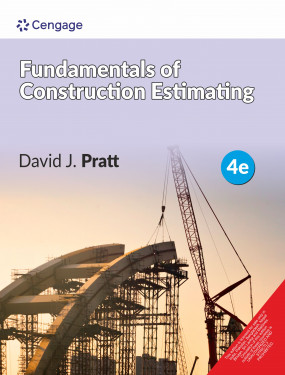
Construction Materials, Methods, and Techniques
ISBN: 9789355739612

Fundamentals of Construction Estimating
ISBN: 9789360538316
Higher Education

Author(s): David Pratt
ISBN: 9788131518687
3rd Edition
Copyright: 2013
India Release: 2012
Binding: Paperback
Pages: 496
Trim Size: 279x216
FUNDAMENTALS OF CONSTRUCTION ESTIMATING 3rd edition presents estimating procedures in a clear and precise manner explaining all the procedures of estimating the cost of construction work such as quantity takeoff, pricing of the contractor's work, pricing sub-trade work, pricing site overhead and compiling bid documents. This book offers readers thorough instruction on the principles of construction estimating and the skills to become a professional estimator by using drawings for two complete projects – one residential and one commercial, thereby leading the reader through the complete estimating process which can be used in various trades on many different types of construction projects.
1.Introduction.
2. The Estimating Process and Preliminary Procedures.
3. Measuring Quantities Generally.
4. Measuring Sitework, Excavation and Piling.
5. Measuring Concrete Work.
6. Measuring Masonry Work.
7. Measuring Carpentry and Miscellaneous Items.
8. Pricing Generally.
9. Pricing Construction Equipment.
10. Pricing Excavation and Backfill.
11. Pricing Concrete Work.
12. Pricing Masonry, Carpentry and Finishes Work.
13. Pricing Subcontractors’ Work.
14. Pricing General Expenses.
15. Closing the Bid.
16. Budget Estimating.
17. Elemental Estimating.
18. Value Analysis.
19. Life-Cycle Costing.
Appendix A: Extract From a Typical Soils Report.
Appendix B: List of Items and CSI-Based Codes.
Appendix C: Glossary.
Appendix D: The Metric System and Conversions.
Index.
David Pratt
David J. Pratt is a Professor of Civil Engineering Technology at SAIT Polytechnic and a lecturer in construction costing at the University of Calgary. Professor Pratt is a professional quantity surveyor and cost consultant. He is a member of the Canadian Institute of Quantity Surveyors, and holds a degree in Quantity Surveying from Liverpool College of Building together with a degree in Economics from the University of Calgary.